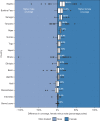Gender equity in mass drug administration for neglected tropical diseases: data from 16 countries
- PMID: 30845318
- PMCID: PMC6748770
- DOI: 10.1093/inthealth/ihz012
Gender equity in mass drug administration for neglected tropical diseases: data from 16 countries
Erratum in
-
Corrigendum to: 'Gender equity in mass drug administration for neglected tropical diseases: data from 16 countries'.Int Health. 2019 Nov 13;11(6):621-622. doi: 10.1093/inthealth/ihz026. Int Health. 2019. PMID: 31044236 Free PMC article. No abstract available.
Abstract
Background: Gender equity in global health is a target of the Sustainable Development Goals and a requirement of just societies. Substantial progress has been made towards control and elimination of neglected tropical diseases (NTDs) via mass drug administration (MDA). However, little is known about whether MDA coverage is equitable. This study assesses the availability of gender-disaggregated data and whether systematic gender differences in MDA coverage exist.
Methods: Coverage data were analyzed for 4784 district-years in 16 countries from 2012 through 2016. The percentage of districts reporting gender-disaggregated data was calculated and male-female coverage compared.
Results: Reporting of gender-disaggregated coverage data improved from 32% of districts in 2012 to 90% in 2016. In 2016, median female coverage was 85.5% compared with 79.3% for males. Female coverage was higher than male coverage for all diseases. However, within-country differences exist, with 64 (3.3%) districts reporting male coverage >10 percentage points higher than female coverage.
Conclusions: Reporting of gender-disaggregated data is feasible. And NTD programs consistently achieve at least equal levels of coverage for women. Understanding gendered barriers to MDA for men and women remains a priority.
Keywords: Sustainable Development Goals; equity; gender; mass drug administration; neglected tropical diseases; public health.
© The Author(s) 2019. Published by Oxford University Press on behalf of Royal Society of Tropical Medicine and Hygiene.
Figures



References
-
- United Nations General Assembly RES/70/1. Transforming our world: the 2030 agenda for sustainable development, 2015.
-
- Sen G, Östlin P, George A Unequal, Unfair, Ineffective and Inefficient Gender Inequity in Health: Why it exists and how we can change it, 2007. - PubMed
Publication types
MeSH terms
LinkOut - more resources
Full Text Sources
Medical

